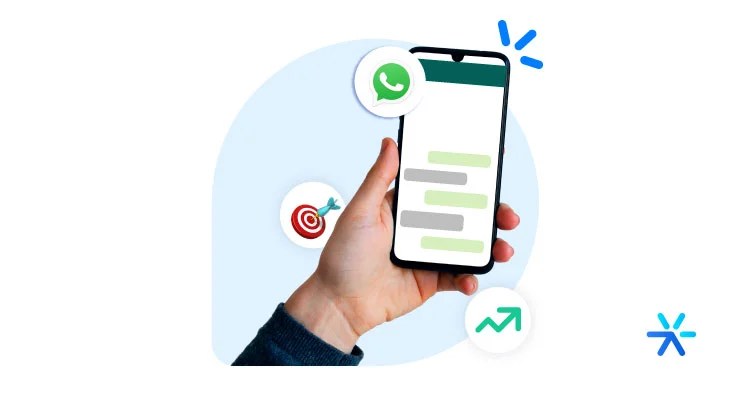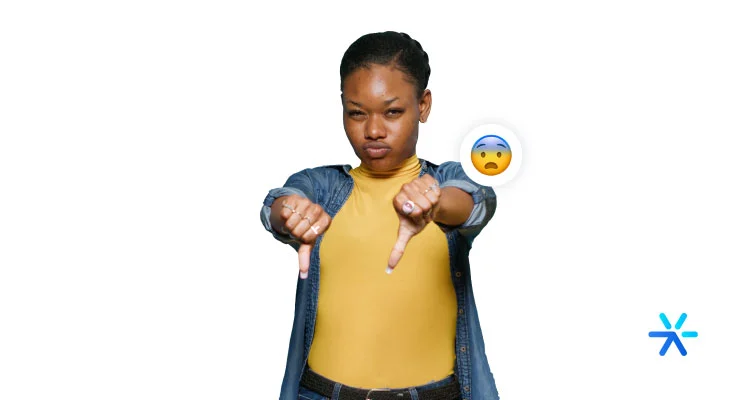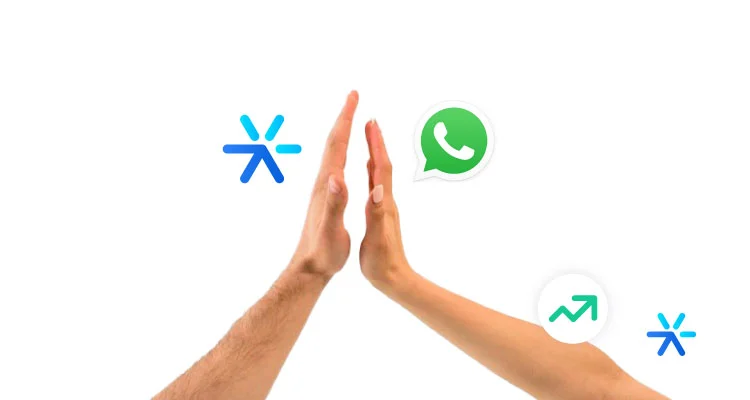WhatsApp Leads: How to Improve Lead Generation on Your Website
Here are two topics that rarely come together: WhatsApp leads.
Yes, WhatsApp itself!
Usually, when we talk about leads, we use other types of tools and strategies.
Content marketing, organic traffic, lead magnet strategies, etc.
WhatsApp, most of the time, ends up being one of the last stages of the marketing and sales funnel: direct contact with the salesperson.
But is that how it should be?
Can’t we do it differently?
Does mixing leads with WhatsApp work?
Of course, it does.
Today we’ll show you some strategies that companies are already using to involve WhatsApp in the lead generation process.
We’ll also discuss its major limitations and how to overcome them.
Starting with the main question: how to generate leads through WhatsApp?
How to generate leads through WhatsApp?

It’s interesting how WhatsApp is often completely ignored as a way to capture leads on your website.
Interesting because, when someone chats with you via WhatsApp, they are automatically converting into a lead, did you know that?
We understand lead conversion as someone who leaves contact information or opens a communication channel with your company.
That’s exactly what WhatsApp offers.
Those more experienced might already be thinking of numerous limitations: GDPR issues, lack of lead organization support, dedicated workers, etc.
It’s normal to have reservations — but we’ll address each of these points as we progress through the article.
Now, let’s explore 6 ways to generate leads through WhatsApp:
Contact button on the website
This is one of the most common ways to generate leads through WhatsApp – by installing a button directly on the website. Screenshot of a website with WhatsApp button
Usually, the WhatsApp button follows the scroll of the website.
By clicking on it, you get access to a link that immediately takes you to a conversation in the app.
Groups for promotion and materials dissemination
Another very popular way to generate WhatsApp leads is through groups that are always offering materials.
Usually, brands invite people to join these groups with arguments like:
- Exclusive materials, only available in the group;
- Direct contact with experts;
- Coverage of an event;
- Discount coupon distribution;
- Extra materials from a course;
Among others.
In these cases, the WhatsApp group becomes a parallel strategy, working alongside common inbound marketing strategies, such as email marketing and content marketing, for example.
Direct approach through the contact list
Some companies have huge contact lists, with several names and phone numbers.
This is very common in stores that require registration for purchases, for example.
Some companies use this contact list to approach customers who haven’t purchased from the store in a while.
In many cases, these lists have such old customers that they don’t even remember having bought anything.
This case is not a direct conversion of WhatsApp leads per se, but it’s almost like it.
Customers can be approached with a more commercial proposal or can undergo nurturing through this channel.
Physical cards with contact information
Generating leads on WhatsApp is a somewhat unusual task, and therefore the ways in which they are generated are also quite unusual, even challenging the concept of leads at times.
It’s very common for sales managers, marketing managers, and executives in general to carry cards with their contact information.
Anyone who contacts you through a link or number on a physical card can be considered a lead.
This is because, in the classic definition, a lead is someone who leaves their contact information and authorizes your company to contact them in the future.
Those who contact you via business cards are doing exactly that.
But at the same time, the characteristic limitations of WhatsApp leads raise doubts.
“Is it really a lead if I don’t have the email?” “If I can’t nurture through WhatsApp, is this lead worth anything?” These are common objections.
A bit more suspense: throughout the article, we’ll address these limitations and provide solutions.
Flyers, billboards, and outbound marketing in general
Some limitations we are mentioning throughout the article concern the mix of concepts: leads normally appear in inbound marketing strategies, and we mentioned some outbound marketing actions.
Handing out business cards, for example, is outbound. A cold contact list too.
The more outbound the action, the more out of place the term “lead” seems to be.
But this is a very “all or nothing” way of looking at marketing: outbound also generates leads.
Thus, flyers, billboards, and even TV commercials are fully capable of generating WhatsApp leads, provided that WhatsApp is the CTA – call to action – defined in these actions.
The problems of generating leads on WhatsApp

We gave some tips on where the main problems of WhatsApp leads come from.
Much of the confusion comes from concepts, like the case of outbound vs. inbound, but some problems are of a practical nature, impacting the day-to-day of the marketing and sales department.
We’ll address the major limitations of generating leads on WhatsApp in this section now.
And the next one will be how to overcome all these problems with a simple solution.
Let’s start with the most obvious problem:
Team availability
This will be the first problem you’ll encounter in generating leads on WhatsApp: scaling your team.
Let’s take the example of a WhatsApp button on your website.
Suppose you’ve never had such a button, and all direct contacts from the site came through a form.
Using the form, requests were sent via email to the sales team, who together determined who should respond to which.
In many cases, contact requests via the form go to a unified email, and the sales team works together to respond to all.
With leads on WhatsApp, the situation changes slightly.
Contacts are sent directly to a single number, which can be divided via WhatsApp Business among multiple computers.
The increase in the number of contacts your site will have with the WhatsApp button can be too much for your team.
Suddenly, a task that was simpler and via email becomes more urgent and disorganized.
Your team will need to respond to contacts often immediately, and sustain multiple conversations throughout the day.
This ends up generating extra work, and not rarely you may have to hire more people and reorganize your department to make these initial contacts and keep them engaged.

Low Lead Qualification
The WhatsApp button also allows direct contact, without any other barrier.
The only information your lead provides is their phone number.
You don’t even know their full name to do a LinkedIn check. 🕵️♂️
This, of course, has significant impacts on lead qualification.
The WhatsApp button adds an outbound element to your strategy, putting qualification aside for a larger volume of leads.
With preparation and an organized marketing team, there’s no problem, just extra work.
You’ll need to design strategies that align with the less qualified nature of these leads, as your inbound strategies won’t apply to them.
It’s also possible to create mechanisms within WhatsApp to qualify within the app, such as a chatbot that qualifies after contact or a personalized message for everyone who enters.
But anyway, if you just put the button on your site and that’s it, leads generated by WhatsApp will be much less qualified than those worked on via inbound.
WhatsApp limbo
Within an inbound marketing strategy, there are flows that take into account practically all actions of a lead.
For example: a lead who requested a free material but didn’t open the delivery email might receive an email saying “hey, didn’t you see the material I sent you?”.
And this is automated, without you needing to separate lead by lead.
On WhatsApp, this is a bit more complicated.
If someone starts a conversation and it develops throughout the day, but in the end, your lead gives up on what they were looking for, where do they go?
This is the WhatsApp limbo.
There can be hundreds of reasons why your lead didn’t want to continue the conversation, reasons that may not even have anything to do with your product or service.
What then? If the first contact doesn’t result in lead qualification progress or a sale, is the lead discarded?
This is one of the biggest problems with WhatsApp leads, and many companies leave it up to the attendants themselves to separate these leads so they don’t fall into limbo.
But people make mistakes and quite often.
Because of this, you lose great opportunities simply because the lead isn’t registered on any other platform — they’re just a conversation on WhatsApp.
It’s not possible to track marketing metrics
WhatsApp Business offers a very simple analytics, where you can track some metrics related to its usage.
The metrics it provides are:
- Average wait time;
- Average handling time;
- Number of messages exchanged;
- Number of open conversations;
According to WhatsApp itself, “this feature shows how many messages are sent, delivered, read, and received”.
That is: the metrics are simple and related only to the messages, not with the lead’s profile or qualification.
If you want to know, for example, how many people clicked the button to request quotes and how many clicked to request support, good luck: time to open a spreadsheet.
Inability to insert the lead into a flow automatically
Companies that implement inbound marketing have a marketing that works through flows.
These flows will always respect the marketing and sales funnel.
It works more or less like this: a visitor enters your site and downloads a lead magnet – an e-book, report, etc.
As soon as this visitor downloads this material, they enter a nurturing flow.
That is: they will receive emails with recommendations for more materials to download, they’ll be qualified until they reach the sale.
All automatic.
With leads on WhatsApp, the situation is a bit different.
They don’t fall into any flow when they click the button, they’re simply redirected to WhatsApp.
If you want them to enter some flow, you’ll need to do the work manually.
Actually, not necessarily.
There’s another way to overcome almost all these difficulties with your WhatsApp-generated leads.
And that’s what we’ll talk about now:
The solution to these problems via Chatbot + WhatsApp

Okay, so we understand that, even though it’s possible to generate leads on WhatsApp and incorporate them into your marketing strategy, the strategy still presents some difficulties that are hard to overcome.
Especially for a company that’s just starting to do this work.
It’s completely possible to integrate WhatsApp into generating qualified leads, and the solution is simpler than you might imagine.
If the problem is qualifying during or after WhatsApp contact, the solution is qualifying beforehand with a chatbot on your site.
It works like this: instead of installing the button that leads directly to the WhatsApp conversation, you add a chatbot to your site.
And configure it so that, after a few simple questions, it delivers the link to WhatsApp.
That way, you still keep the WhatsApp button on your site, but to start the conversation, you ask for some simple information.
Let’s delve deeper into this technique in the next sections.
Initial lead preparation before going to WhatsApp
As mentioned, one of the biggest problems with WhatsApp leads is starting the conversation without the minimum information about them, the lead.
With a chatbot installed on your site, it acts as a redirection platform.
Your visitor talks to the chatbot first, offering some crucial information: name, email, company they work for, contact subject, etc.
This way, you don’t work “in the dark”.
You know the basics about the lead before engaging with them.
Leads with the chatbot can be inserted into a relationship flow
It’s the end of the WhatsApp limbo, one of your biggest problems when it comes to generating and qualifying leads.
Remember I mentioned this difficulty?
If the contact doesn’t end with an action, the lead gets “lost”, requiring manual addition to your nurturing flows.
When you install a chatbot on your site and, through it, forward leads to WhatsApp, there’s no chance of that lead getting lost.
They can be inserted into your relationship flow.
Leadster offers this functionality, with its own system for creating flows, and integrates with the best CRMs and inbound platforms on the market.
All metrics are saved in the Chatbot
Just to recap: WhatsApp Business offers some metrics of its own, but all related to message sending.
How many were sent, average conversation time, etc.
And that’s it! What about other site-related metrics?
We can think of some quickly as an exercise:
- WhatsApp service rejection rate;
- How many times the lead has talked to the chatbot;
- What commands the lead gave to the chatbot;
- What types of leads choose to chat on WhatsApp;
- How many leads that initiate contact are really qualified;
- What is the conversion rate on each site page or your chatbot’s call to action.
Among many others.
The approach is proactive from the first contact
The WhatsApp button often sits on the site for aesthetic reasons or “it must be there, so it is”.
The issue is that it alone at the bottom, waiting for someone to click, doesn’t generate many leads and contact requests.
The chatbot solves this problem by making an initial approach itself.
This kind of personalized and proactive approach is much better than a static button.
We’ve seen increases of up to 3 times in lead generation with it.
With qualification, contacts can go directly to the responsible department’s seller
Another problem to check off the list: the chaotic workflow of the sales team when a WhatsApp button is installed.
With a chatbot, everything becomes much simpler.
You can create one or more levels of qualification before contact, which makes life easier for the sales team.
It works like this: the contact will already arrive on WhatsApp with some basic information, without needing the sales team to start the conversation just to understand what the lead wants.
Qualified leads = more sales
Overall, we all know that qualified leads generate more sales.
And this wouldn’t be different in the case of WhatsApp leads.
The amount of information the salesperson has when there’s a previous lead qualification makes all the difference.
Instead of knowing just their name, the responsible seller also has access to crucial information.
Information that can even disqualify that lead for a commercial approach.
Just think: two contacts simultaneously reach the commercial team’s WhatsApp.
A salesperson starts working on the first one who arrived, only to understand after 30 minutes that their company isn’t ready for their product.
Meanwhile, the other lead went to do other things and forgot to continue the conversation.
And your company was ready for the sale.
That kind of decision can’t take long.
And with previous qualification, the salesperson can choose to prioritize the contact requests that are more likely to result in a sale.
How Leadster works with WhatsApp?
Everything we mentioned in this final part of the text are functionalities of Leadster, did you know?
And even more that improve your company’s sales routine.
In the previous section, we were talking about redirecting to the commercial team’s WhatsApp, right?
With Leadster, you can send the contact directly to a specific seller’s WhatsApp, with all relevant information.
You can even make a “roulette” – all contact requests are passed on to up to 12 different numbers, one at a time.
The functionalities and possibilities are immense.
I invite you to take a test to understand more about what we can offer you — it’s free and valid for 14 days, no credit card required.
All set to change your company for the better?








